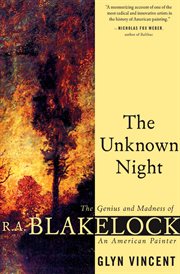Nonfiction
eBook
Details
PUBLISHED
Made available through hoopla
DESCRIPTION
1 online resource
ISBN/ISSN
LANGUAGE
NOTES
On February 22, 1916, Ralph Albert Blakelock's haunting landscape, Brook by Moonlight, was sold at auction for $20,000, a record price for a painting by a living American artist. The sale made him famous, newspapers called him America's greatest artist, and thousands flocked to exhibits of his work. Yet at the time of his triumph Blakelock had spent 15 years confined in a psychiatric hospital in upstate New York and his wife and children were living in poverty. Released from the asylum by a young philanthropist, Blakelock was about to become the victim of one of the most heartless con games of the century. This remarkable biography chronicles the life, times and madness of one of America's most celebrated and exploited painters whose brooding, hallucinogenic landscapes anticipated Abstract Expressionism by more than half a century. Like the best biographies, The Unknown Night brings to life a vanished world, as well. In this case, it's late 19th and early 20th century New York a city of artists' studios and spiritualists' salons, shantytowns and millionaires' mansions. Blakelock was a mystic who as a young man wandered among the Indians out West, and on his return frequented the spiritualist circles in New York City. Though he was regarded as a loner, he worked among the great painters of his time, artists like William Merritt Chase and George Inness. Blakelock initially painted in the Romantic style of the Hudson River School, but by the 1880s, his brooding, hallucinogenic landscapes were considered among the most controversial, radical paintings of the era. In the 1890s he fell on hard times and sometimes played the piano on the vaudeville circuit to earn extra cash. He suffered his first mental breakdown in 1891. After a period of remission he became violent and was institutionalized in 1899 just as his reputation was beginning to soar. Interest in his work peaked in 1916 when a wave of Blakelock hysteria swept America. Crowds lined up to see Blakelock exhibitions in New York, Chicago and San Francisco. Wealthy collectors bid record prices for his haunting paintings. Blakelock was released from the asylum and seemed destined for a glorious and comfortable end. Instead, fed upon by opportunistic dealers and forgers, Blakelock became entangled in a web of deceit spun by the very woman who was supposed to be his savior. Vincent begins his story in the spring of 1916 when Blakelock's canvas, The Brook by Moonlight, was auctioned at the Plaza Hotel in New York for $20,000 - a record price at that time for the work of a living American painter. It was Blakelock's second record in three years. Newspaper reporters converged on the painter and art pundits tripped over each other in doling out praise for his mysterious nocturnal landscapes. Few American artists deserve a higher niche in the Temple of Fame, drooled the pioneering art dealer, William Macbeth. Some were calling Blakelock the greatest American landscape painter ever. At the time, Blakelock was penniless, a resident of an asylum in Middletown, New York. His wife, Cora Bailey Blakelock was living in poverty with their youngest children in a small house in the Catskills. Blakelock may well have remained locked away if it had not been for the efforts of Mrs. Van Rensselaer Adams, a 32-year-old vamp with a shady past. Adams passed herself off as a philanthropist, rescued Blakelock from the asylum, and brought him to New York City to generate public sympathy for the artist and his family. She had arranged a large show of his paintings at the Reinhardt Gallery on Fifth Avenue. It was a huge success attracting all the major critics and large crowds throughout its run over seven months. A committee of venerable art personages was formed to collect the proceeds from Blakelock's work to be passed on to his wife and children. Blakelock, all dressed up for the Gallery opening, cut a dashing figure. His wife, though, was nowhere to be seen
Mode of access: World Wide Web







